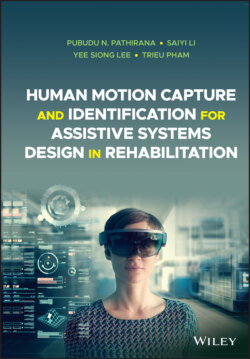Читать книгу Human Motion Capture and Identification for Assistive Systems Design in Rehabilitation - Pubudu N. Pathirana - Страница 22
1.4.1 Summary and challenges
ОглавлениеFrom the literature, it is clear that a number of sensors have been applied in telerehabilitation. For the evaluation of the approaches introduced in this thesis, we utilised Kinect as the example of affordable OBMCDs to collect data for the following two major reasons.
First of all, Kinect is a non‐contact motion capture device. Patients do not need to attach any extra item to their bodies. As a result, they may be able to perform rehabilitation exercises or ADLs with more natural poses.
Secondly, compared to conventional RGB cameras, Kinect is able to track 3D positions of 20–25 joints throughout a human body. Therefore, without making much effort in processing images, data collected from a Kinect are much more convenient for further analysis. This is critical for automatically assessing the kinematic performance of patients in a telerehabilitation system without the presence of a professional therapist.
However, the majority of affordable OBMCDs still suffer from a number of drawbacks. One is that it may not be accurate enough to track small movements, as well as the positions of joints occluded by other body parts. Secondly, its small viewing range limits its application in lower extremity rehabilitation, which, in many cases, involves a large moving area. A solution for these limitations is discussed in Chapter 2.
